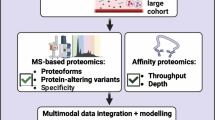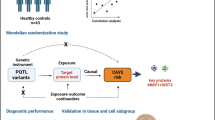Abstract
Aims
Increasing evidence suggests a potential role of circulating miRNAs as clinical biomarkers, and loss of miRNA-126 has been proposed as a predictor of type 2 diabetes onset. However, a systematic analysis of circulating miRNAs in type 1 diabetic patients with micro-/macrovascular complications has not yet been performed.
Methods
A cross-sectional nested case–control study from the EURODIAB Prospective Complications Study of 455 type 1 diabetic patients was performed. Case subjects (n = 312) were defined as those with one or more complications of diabetes; control subjects (n = 143) were those with no evidence of any complication. A differential miRNA expression profiling was performed in pooled serum samples from cases and controls. Furthermore, miR-126 levels were quantified by qPCR in all individual samples and associations with diabetic complications investigated.
Results
Twenty-five miRNAs differed in pooled samples from cases and controls. miR-126 levels were significantly lower in case than in control subjects, even after adjustment for age and sex. In logistic regression analyses, miR-126 was negatively associated with all complications (OR = 0.85, 95 % CI 0.75–0.96) as well as with each micro-/macrovascular complication examined separately. This was likely dependent of diabetes as associations were no longer significant after adjustment for both hyperglycemia and diabetes duration. However, a significant 25 % risk reduction, independent of age, sex, A1C, and diabetes duration, was still observed for proliferative retinopathy (OR = 0.75, 95 % CI 0.59–0.95).
Conclusions
In this large cohort of type 1 diabetic subjects, we found that miR-126 levels are associated with vascular complications of diabetes, particularly with proliferative retinopathy.
Similar content being viewed by others
References
He L, Hannon GJ (2004) MicroRNAs: small RNAs with a big role in gene regulation. Nat Rev Genet 5:522–531
Filios SR, Shalev A (2015) β-Cell microRNAs: small but powerful. Diabetes 64:3631–3644
Beltrami C, Angelini TG, Emanueli C (2014) Noncoding RNAs in diabetes vascular complications. J Mol Cell Cardiol 89:42–50
Shantikumar S, Caporali A, Emanueli C (2012) Role of microRNAs in diabetes and its cardiovascular complications. Cardiovasc Res 93:583–593
Mitchell PS, Parkin RK, Kroh EM et al (2008) Circulating miRNAs as stable blood-based markers for cancer detection. Proc Natl Acad Sci USA 105:10513–10518
Tanaka M, Oikawa K, Takanashi M et al (2009) Down-regulation of miR-92 in human plasma is a novel marker for acute leukemia patients. PLoS ONE 4:e5532
Laterza OF, Lim L, Garrett-Engele PW et al (2009) Plasma miRNAs as sensitive and specific biomarkers of tissue injury. Clin Chem 55:1977–1983
McManus DD, Ambros V (2011) Circulating miRNAs in cardiovascular disease. Circulation 124:1908–1910
Nielsen LB, Wang C, Sørensen K, et al (2012) Circulating levels of microRNA from children with newly diagnosed type 1 diabetes and healthy controls: evidence that miR-25 associates to residual beta-cell function and glycaemic control during disease progression. Exp Diabetes Res 2012:896362. doi:10.1155/2012/896362
Zampetaki A, Kiechl S, Drozdov I et al (2010) Plasma microRNA profiling reveals loss of endothelial miR-126 and other microRNAs in type 2 diabetes. Circ Res 107:810–817
Zampetaki A, Willeit P, Burr S et al (2016) Angiogenic microRNAs linked to incidence and progression of diabetic retinopathy in type 1 diabetes. Diabetes 65:216–227
Pezzolesi MG, Satake E, McDonnell KP et al (2015) Circulating TGF-β1-regulated miRNAs and the risk of rapid progression to ESRD in type 1 diabetes. Diabetes 64:3285–3293
The EURODIAB IDDM Complications Study Group (1994) Microvascular and acute complications in IDDM patients: the EURODIAB IDDM complications study. Diabetologia 3:278–285
Chaturvedi N, Sjoelie AK, Porta M et al (2001) EURODIAB prospective complications study: markers of insulin resistance are strong risk factors for retinopathy incidence in type 1 diabetes. Diabetes Care 24:284–289
Schram MT, Chaturvedi N, Schalkwijk CG et al (2005) EURODIAB prospective complications study group. Markers of inflammation are cross-sectionally associated with microvascular complications and cardiovascular disease in type 1 diabetes: the EURODIAB prospective complications study. Diabetologia 48:370–378
Gruden G, Bruno G, Chaturvedi N et al (2009) EURODIAB prospective complications study group. ANTI-HSP60 and ANTI-HSP70 antibody levels and micro/macrovascular complications in type 1 diabetes: the EURODIAB study. J Intern Med 266:527–536
Gruden G, Bruno G, Chaturvedi N et al (2008) EURODIAB prospective complications study group. Serum heat shock protein 27 and diabetes complications in the EURODIAB prospective complications study: a novel circulating marker for diabetic neuropathy. Diabetes 57:1966–1970
Burt D, Bruno G, Chaturvedi N et al (2009) Anti-heat shock protein 27 antibody levels and diabetes complications in the EURODIAB study. Diabetes Care 32:1269–1271
Chaturvedi N, Schalkwijk CG, Abrahamian H et al (2002) EURODIAB prospective complications study group. Circulating and urinary transforming growth factor beta1, Amadori albumin, and complications of type 1 diabetes: the EURODIAB prospective complications study. Diabetes Care 25:2320–2327
Giunti S, Bruno G, Lillaz E et al (2007) EURODIAB IDDM complications study group. Incidence and risk factors of prolonged QTc interval in type 1 diabetes: the EURODIAB prospective complications study. Diabetes Care 30:2057–2063
Levey AS, Bosch JP, Lewis JB et al (1999) A more accurate method to estimate glomerular filtration rate from serum creatinine: a new prediction equation. Modification of diet in renal disease study group. Ann Intern Med 130:461–470
Harris TA, Yamakuchi M, Ferlito M et al (2008) MicroRNA-126 regulates endothelial expression of vascular cell adhesion molecule 1. Proc Natl Acad Sci USA 105:1516–1521
Martin MM, Lee EJ, Buckenberger JA et al (2006) MicroRNA-155 regulates human angiotensin II type 1 receptor expression in fibroblasts. J Biol Chem 281:18277–18284
Martin MM, Buckenberger JA, Jiang J et al (2007) The human angiotensin II type 1 receptor +1166 A/C polymorphism attenuates microRNA-155 binding. J Biol Chem 282:24262–24269
Barutta F, Tricarico M, Corbelli A et al (2013) Urinary exosomal microRNAs in incipient diabetic nephropathy. PLoS ONE 8:e73798
Fichtlscherer S, De Rosa S, Fox H et al (2010) Circulating microRNAs in patients with coronary artery disease. Circ Res 107:677–684
Wang C, Wan S, Yang T et al (2016) Increased serum microRNAs are closely associated with the presence of microvascular complications in type 2 diabetes mellitus. Sci Rep 6:20032
Spinetti G, Fortunato O, Caporali A et al (2013) MicroRNA-15a and microRNA-16 impair human circulating proangiogenic cell functions and are increased in the proangiogenic cells and serum of patients with critical limb ischemia. Circ Res 112:335–346
Wang F, Long G, Zhao C et al (2013) Plasma microRNA-133a is a new marker for both acute myocardial infarction and underlying coronary artery stenosis. J Transl Med 11:222
Afanasyeva EA, Mestdagh P, Kumps C et al (2011) MicroRNA miR-885-5p targets CDK2 and MCM5, activates p53 and inhibits proliferation and survival. Cell Death Differ 18:974–984
van Solingen C, Bijkerk R, de Boer HC et al (2015) The role of microRNA-126 in vascular homeostasis. Curr Vasc Pharmacol 13:341–351
Asgeirsdóttir SA, van Solingen C, Kurniati NF et al (2012) MicroRNA-126 contributes to renal microvascular heterogeneity of VCAM-1 protein expression in acute inflammation. Am J Physiol Renal Physiol 302:F1630–F1639
Jansen F, Yang X, Hoelscher M et al (2013) Endothelial microparticle-mediated transfer of MicroRNA-126 promotes vascular endothelial cell repair via SPRED1 and is abrogated in glucose-damaged endothelial microparticles. Circulation 128:2026–2038
Zhang T, Lv C, Li L et al (2013) Plasma miR-126 is a potential biomarker for early prediction of type 2 diabetes mellitus in susceptible individuals. Biomed Res Int 2013:761617
Zhang Y, Wang X, Xu B et al (2013) Epigenetic silencing of miR-126 contributes to tumor invasion and angiogenesis in colorectal cancer. Oncol Rep 30:1976–1984
Chen H, Li L, Wang S et al (2014) Reduced miR-126 expression facilitates angiogenesis of gastric cancer through its regulation on VEGF-A. Oncotarget 5:11873–11885
Ye P, Liu J, He F et al (2013) Hypoxia-induced deregulation of miR-126 and its regulative effect on VEGF and MMP-9 expression. Int J Med Sci 11:17–23
van Solingen C, de Boer HC, Bijkerk R et al (2011) MicroRNA-126 modulates endothelial SDF-1 expression and mobilization of Sca-1(+)/Lin(-) progenitor cells in ischaemia. Cardiovasc Res 92:449–455
Butler JM, Guthrie SM, Koc M et al (2005) SDF-1 is both necessary and sufficient to promote proliferative retinopathy. J Clin Invest 115:86–93
McManus DD, Freedman JE (2015) MicroRNAs in platelet function and cardiovascular disease. Nat Rev Cardiol 12:711–717
Acknowledgments
This work was supported by the “European Foundation for the Study of Diabetes.”
Author information
Authors and Affiliations
Corresponding author
Ethics declarations
Conflict of interest
None.
Human and animal rights
All procedures followed were in accordance with the ethical standards of the responsible committee on the human experimentation (institutional and national) and with the Helsinki Declaration of 1975, as revised in 2008.
Informed consent
Informed consent was obtained from all individual participants included in the study.
Additional information
Managed by Massimo Porta.
Electronic supplementary material
Below is the link to the electronic supplementary material.
Rights and permissions
About this article
Cite this article
Barutta, F., Bruno, G., Matullo, G. et al. MicroRNA-126 and micro-/macrovascular complications of type 1 diabetes in the EURODIAB Prospective Complications Study. Acta Diabetol 54, 133–139 (2017). https://doi.org/10.1007/s00592-016-0915-4
Received:
Accepted:
Published:
Issue Date:
DOI: https://doi.org/10.1007/s00592-016-0915-4




